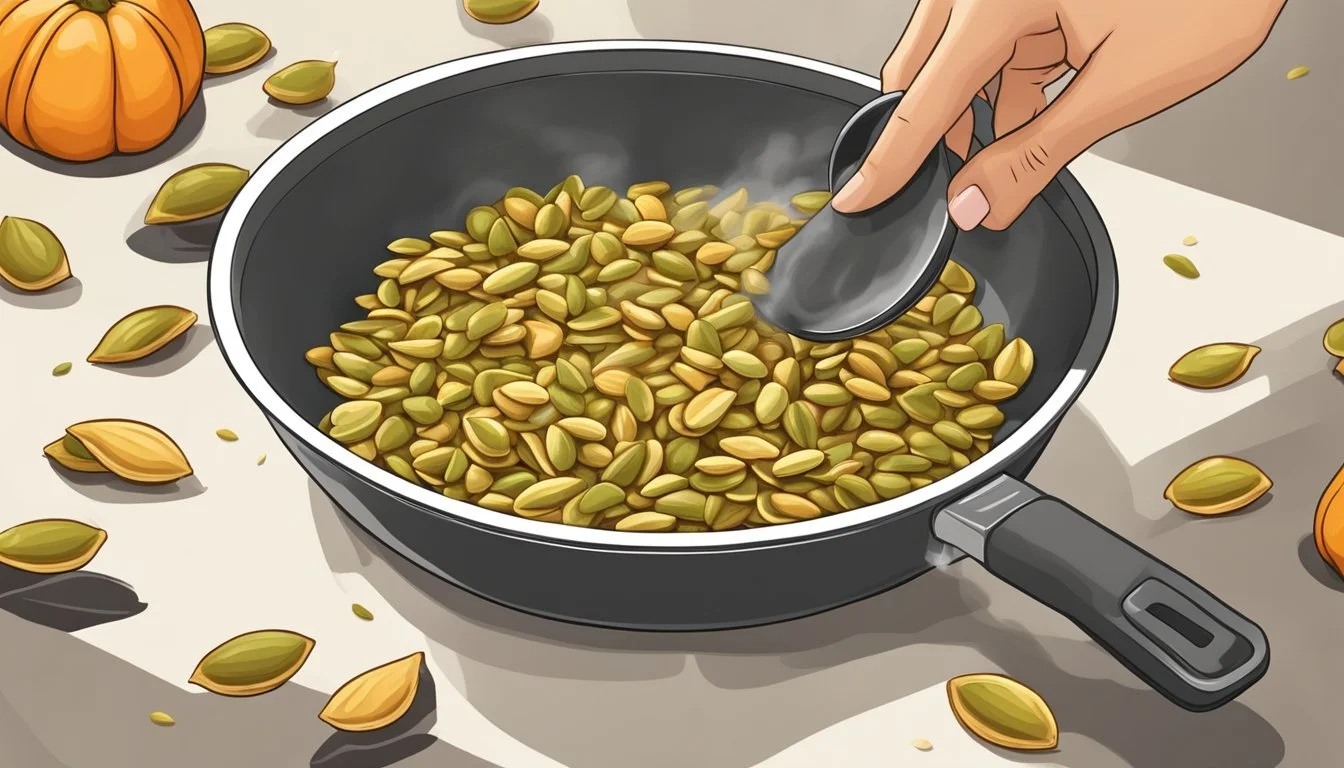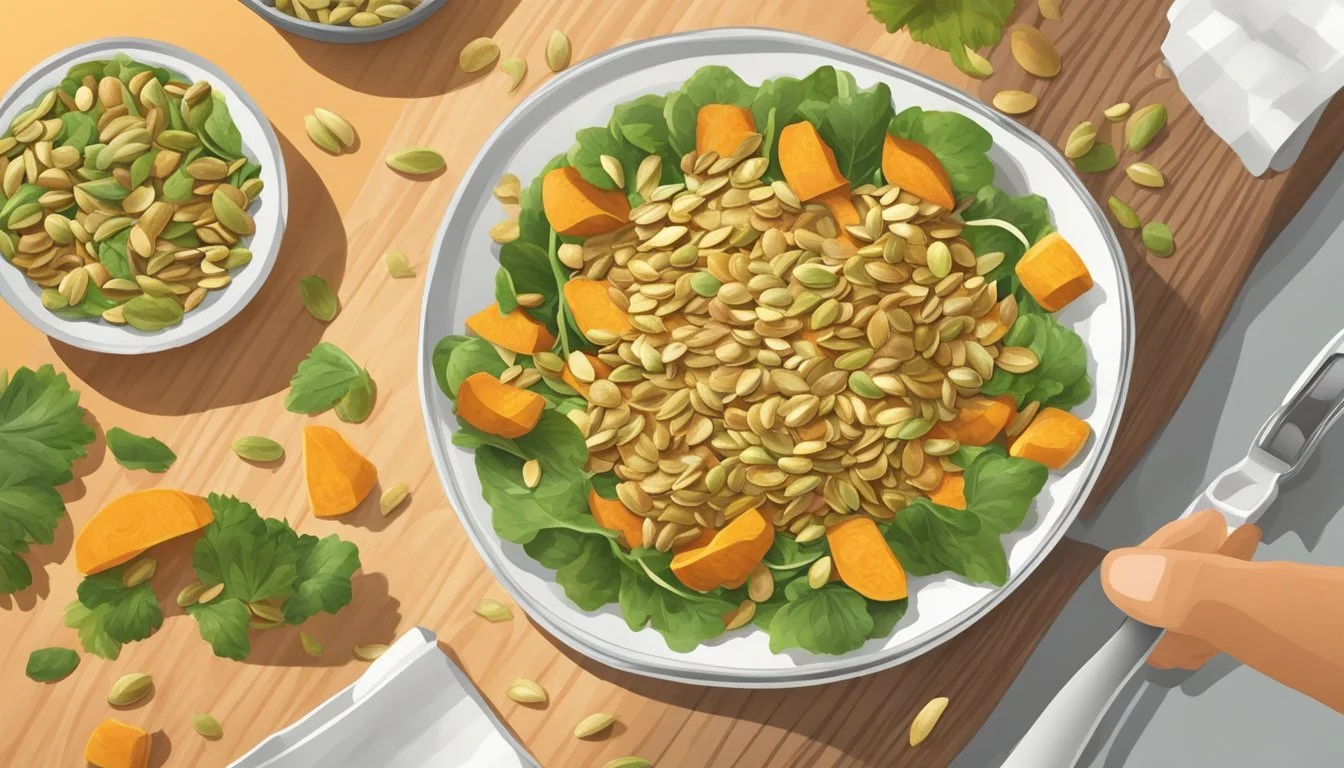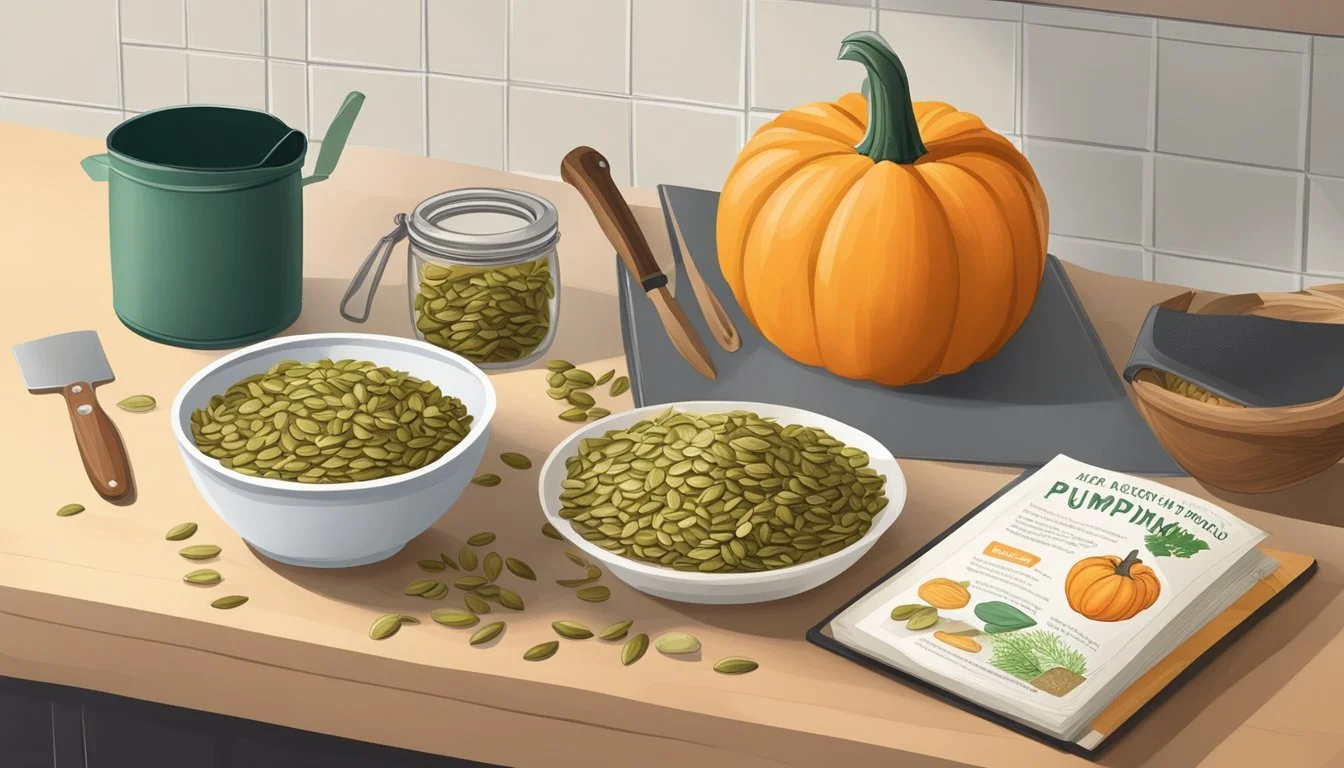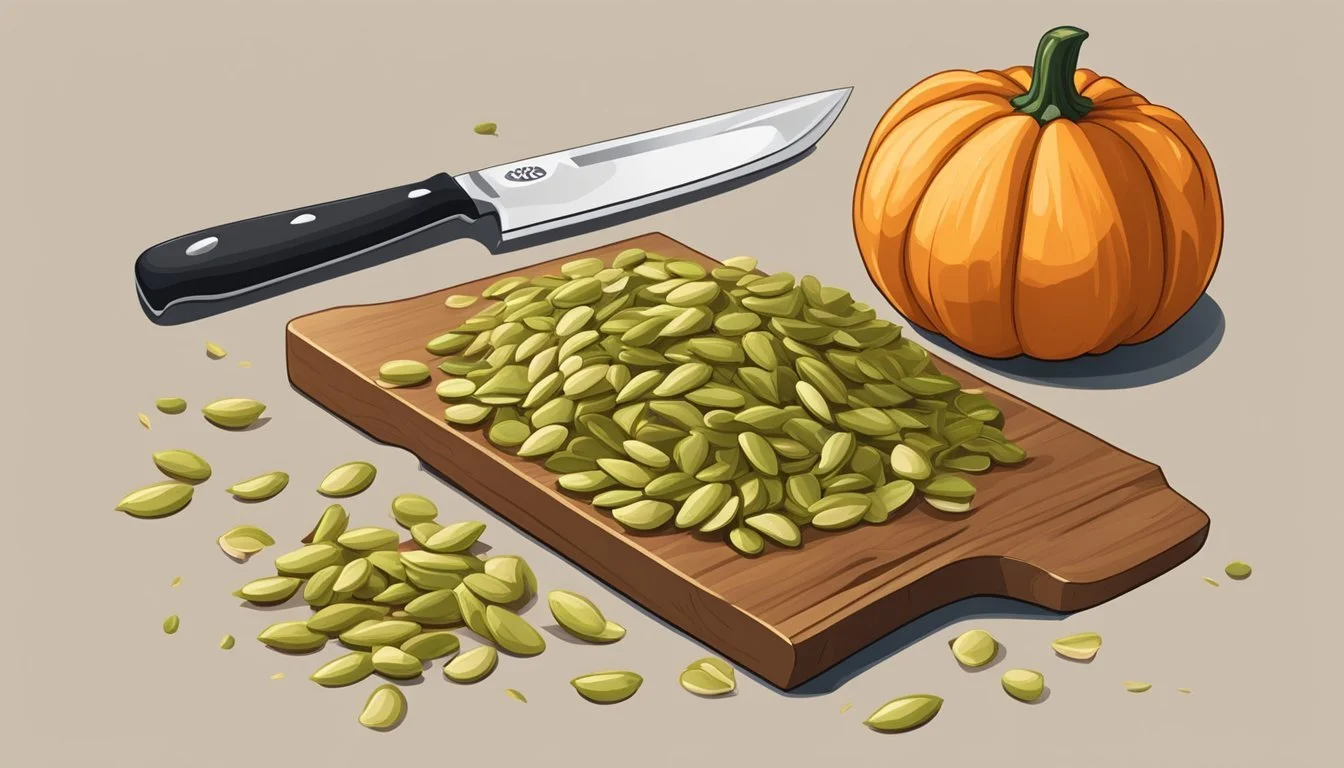How to Cook with Pumpkin Seeds for a Crunchy Addition
Elevate Your Dishes
Cooking with pumpkin seeds is a simple yet rewarding endeavor that not just health enthusiasts, but anyone searching for a nutritious, crunchy addition to their diet can enjoy. These seeds are known for their versatility, capable of enhancing the texture and flavor profile of various dishes. Pumpkin seeds, also referred to as pepitas, can be roasted to a golden crispness and sprinkled atop salads, blended into pesto, or even incorporated into baked goods for an unexpected crunch.
The preparation process of pumpkin seeds is straightforward, beginning with the removal of seeds from the pumpkin's pulp and rinsing them under water to cleanse them of any remaining strings or flesh. Once cleaned, the seeds benefit from a drying phase—a step that is crucial for achieving the desired crunchy texture upon roasting. Chefs around the world utilize pumpkin seeds to elevate their culinary creations, embracing their nutty taste and the delightful contrast they offer when combined with softer ingredients.
Incorporating pumpkin seeds into one's cooking routine is not only a taste-forward decision but also one that reaps nutritional benefits. These seeds are dense with essential nutrients such as magnesium, zinc, and healthy fats. This integration allows for a creative approach to wholesome eating, where one does not have to compromise on taste to maintain a balanced diet. Whether tossed in seasoning and roasted to golden perfection or used as a garnish, pumpkin seeds stand as a testament to the beautiful simplicity and robust flavors that can be harnessed from nature's offerings.
Nutritional Benefits of Pumpkin Seeds
Pumpkin seeds, also known as pepitas, are powerhouses of nutrition, densely packed with essential macronutrients and a spectrum of vitamins and minerals.
Macronutrients
Pumpkin seeds boast a substantial macronutrient profile. One ounce of pumpkin seeds contains roughly 160 calories, primarily comprised of protein and healthy fats. Specifically, they provide about 9 grams of protein, which is vital for muscle repair and growth. The seeds are also rich in omega-6 and omega-3 fatty acids, contributing to cardiovascular health. The fat content is significant but predominantly comes from unsaturated fats, with a minimal amount of saturated fat. Additionally, they include a good amount of dietary fiber, which aids digestion and steadies blood sugar levels.
Vitamins and Minerals
In terms of micronutrients, pumpkin seeds are an excellent source. They provide a significant amount of magnesium, an essential mineral for over 300 biochemical reactions in the body, such as nerve and muscle function. Iron is another key mineral found in pumpkin seeds, critical for oxygen transport in the blood. Moreover, they are high in zinc, which supports immune function, and manganese, important for bone health and metabolism. As for vitamins, pumpkin seeds are a good source of vitamin K, important for blood clotting and bone health. While they are not a significant source of vitamin C or vitamin A, they still contribute to overall nutrition. The seeds are naturally low in sodium, making them a heart-healthy choice when unsalted. They also contain trace amounts of potassium, calcium, and other minerals that are beneficial for overall health.
Preparing Pumpkin Seeds
Proper preparation of pumpkin seeds ensures a crunchy and flavorful snack. It involves cleaning, drying, and seasoning the seeds before roasting them to perfection.
Cleaning and Drying
To begin, one must remove the seeds from the pumpkin, separating them from the stringy pumpkin guts. It’s crucial to rinse the pumpkin seeds under cold water to remove any residual pumpkin bits. After thorough cleaning, drying the seeds is essential to achieve a satisfying crunch. One can pat the seeds dry with a towel or let them sit out to air dry for a few hours.
Preheating the Oven
Prior to roasting, preheating the oven is a key step. For a slow roast that brings out the nuttiness of pumpkin seeds (pepitas), the oven should be set to 300°F (150°C). Lining a baking sheet with parchment paper prepares the cooking surface for the seeds and facilitates easy cleanup.
Seasoning Choices
One has diverse choices when it comes to seasoning pumpkin seeds. For a classic taste, tossing the seeds with 1-2 tablespoons of olive oil and a generous sprinkle of sea salt will suffice. More adventurous flavors can be achieved by adding a mixture of garlic powder and cayenne for heat, or cinnamon and sugar for a sweet variant.
Classic: Olive oil + Sea salt
Sweet: Olive oil + Cinnamon + Sugar
Spicy: Olive oil + Garlic powder + Cayenne
After evenly coating the seeds with the chosen seasonings, spread them in a single layer on the prepared baking sheet to ensure even roasting.
Roasting Pumpkin Seeds
Roasting pumpkin seeds is a simple yet satisfying process. The key is to achieve golden, crispy seeds through proper heat management and timing.
Roasting Techniques
One begins by preheating the oven—325°F (162°C) is typically recommended for a gentle roast that brings out the seeds' nutty flavor without burning them. Meanwhile, seeds should be prepared by rinsing them clean of pumpkin goop and drying thoroughly. Once the seeds are ready, toss them with a bit of oil and, if desired, seasonings.
Next, it's important to spread the seeds in a single layer on a parchment-lined baking sheet. This ensures even heat distribution and helps prevent the seeds from steaming rather than roasting.
The total time for roasting can vary, usually around 20-45 minutes depending on the oven and seed size, but one should be attentive and stir the seeds occasionally.
Determining Doneness
To ascertain whether the pumpkin seeds are done roasting, look for a light golden color and listen for a subtle popping sound. Another indicator is the texture; the seeds should be crispy when cooled slightly and tasted. Cook time may adjust slightly based on the oven's actual temperature, so it's recommended to start checking for doneness at the 20-minute mark.
As a final note, avoid any temptation to increase the heat substantially to reduce the roast time. High temperatures can cause uneven roasting and burnt seeds. Patience yields the best crunchy texture.
Creative Flavor Combinations
The versatility of pumpkin seeds allows for a wide array of flavor combinations, ranging from sweet treats reminiscent of autumn, to savory snacks (What wine goes well with savory snacks?) that can spice up any dish.
Sweet Variations
Pumpkin seeds can be easily transformed into a sweet snack. A simple preparation might include coating the seeds in a mixture of melted butter or oil with a generous sprinkle of cinnamon and brown sugar or maple syrup. For a lighter sweetness, honey serves as a natural sweetener offering a sticky, flavorful glaze that caramelizes beautifully when roasted.
Honey and Cinnamon: Toss seeds in honey, dust with cinnamon, and bake until crisp.
Maple and Brown Sugar: Blend seeds with maple syrup and sprinkle brown sugar before roasting.
Savory Variations
On the savory side, garlic and cheese make a satisfying combination. A dusting of garlic powder adds a robust flavor, while grated Parmesan or another preferred cheese contributes a salty, umami touch. Beyond this, one might opt for the classic simplicity of roasting seeds with a coating of high-quality sea salt or kosher salt, adding ground pepper to add a warm, spicy note.
Garlic Parmesan: Combine seeds with garlic powder and shredded Parmesan, roast until golden.
Salt & Pepper: Mix seeds with oil, season with sea salt and cracked pepper, then bake.
Spicy Variants
For those who prefer a bit of heat, spice blends can elevate the humble pumpkin seed to new heights. Chili powder and cumin offer a smoky edge suited for fans of Tex-Mex cuisine. Alternatively, a Cajun-inspired mix incorporating spices like cayenne pepper can provide a fierce kick.
Chili Cumin Twist: Sprinkle seeds with a mix of chili powder and cumin, roast for a smoky flavor.
Cajun Heat: Toss seeds with a blend of Cajun spices, bake until they're crisp and spicy.
Using Pumpkin Seeds in Recipes
Pumpkin seeds, with their nutty flavor and crunchy texture, are a versatile ingredient that can enhance a variety of dishes. From simple snacks to elaborate entrees, incorporating pumpkin seeds can provide both nutritional benefits and a satisfying crunch.
Snacks and Salads
A handful of toasted pumpkin seeds can elevate a basic snack into a healthful treat. They can be seasoned with ingredients like cumin or smoked paprika for a smoky flare or simply tossed with sea salt for simplicity. For salads, pumpkin seeds add a delightful crunch. They can be sprinkled over a mixed greens salad or stirred into a homemade granola mix, offering not just texture but also a booster of essential minerals.
Homemade Granola Recipe:
2 cups oats
1 cup almonds
1/2 cup pumpkin seeds
1/4 cup honey or maple syrup
1 tsp vanilla extract
Pinch of salt
1/2 tsp cinnamon
Mix the ingredients, spread on a baking sheet, and bake until golden.
Baked Goods and Desserts
Incorporating pumpkin seeds into baked goods and desserts not only adds texture but also a nutritional punch. One can easily mix them into cookie dough or muffin batter. For those who love pumpkin pie, a sprinkle of pumpkin seeds on top before baking adds an artisan touch. Additionally, a crust made from crushed pumpkin seeds offers a gluten-free alternative for pies and cheesecakes.
Pumpkin Seed Cookie Ingredients:
1 cup all-purpose flour
1/2 cup softened butter
1/4 cup sugar
1/2 cup roasted pumpkin seeds
1 tsp vanilla extract
The cookie recipe is simple: combine ingredients, form into cookies, and bake until set.
Soups and Entrées
Pumpkin seeds can also become a star in soups and entrees. They serve well as a garnish for soups, adding a contrasting texture to creamy pumpkin puree or squash soups. When it comes to main dishes, crushed pumpkin seeds can form a crust for meats or fish, providing a unique flavor and satisfying crunch. This ingredient's adaptability shines through in these diverse applications, making it easy to incorporate into any recipe calling for a crunchy element.
Example Entrée Garnish:
Serve a handful of toasted pumpkin seeds atop butternut squash soup.
Meat Crust Recipe:
Crushed pumpkin seeds
Salt and pepper to taste
Press onto the surface of meat or fish before cooking.
Pumpkin seeds' simple ingredients allow them to adapt and meld with a wide array of flavors, making them a truly versatile addition to many dishes.
Storing Roasted Pumpkin Seeds
When preserving the crunch and flavor of roasted pumpkin seeds, storage is key. They should be kept in an airtight container, such as a mason jar or a plastic container with a tight seal. This prevents moisture and air from compromising the seeds' quality.
Before storing, one must ensure the seeds have cooled completely after roasting. Warm seeds can lead to condensation inside the container, making them soggy. Once cool, follow these steps for optimal storage:
Transfer: Place the seeds in an airtight container.
Seal: Check the container is sealed properly.
Label: Mark the container with the date of storage.
For best results, store the container in a cool, dry place like a pantry. Avoid areas near heat sources or in direct sunlight, as these conditions can shorten the seeds' shelf life.
To maintain freshness, consume the seeds within:
Storage Location Estimated Shelf Life Pantry 1-2 months Refrigerator Up to 3 months Freezer Up to 4 months or more
Remember, these time frames are estimates and can vary based on specific storage conditions. Regularly check the seeds for any signs of spoilage, such as a musty smell or change in texture, and dispose of any that are not up to standard.
Health Benefits beyond Nutrition
Pumpkin seeds are a healthy snack choice, offering more than just nutrition information packed with nutrients. They play a unique role that extends into various health aspects.
Stress Relief: Pumpkin seeds contain magnesium, which is known for its relaxation properties. Regular consumption can help in the reduction of stress and anxiety. They are an excellent choice for a calming snack.
Sleep Quality: They are rich in tryptophan, an amino acid that can be converted into serotonin and then melatonin, the sleep hormone. A handful before bed can promote better sleep patterns.
Antimicrobial Benefits: The seeds possess antimicrobial properties that can help fight against harmful bacteria and fungi. This can be particularly beneficial for overall gut health.
Anti-inflammatory: They have anti-inflammatory effects which can contribute to relieving pain and reducing inflammation. This makes them a good snack choice for those with inflammatory conditions.
Nutrient Benefit Zinc Immune support Iron Oxygen carrier Copper Energy production Protein Muscle repair
In moderation, these seeds are a convenient and tasty way to introduce a range of health benefits beyond standard nutritional value, making them an excellent addition to a balanced diet.
Pumpkin Seeds Harvesting Techniques
When harvesting pumpkin seeds, one should start by selecting the perfect pumpkin—preferably one that is fully matured and harvested after the fruit's outer shell hardens. Cut the pumpkin open, which is a common practice around Halloween for pumpkin carving, but also serves the purpose of seed extraction.
After opening the pumpkin, use a sturdy spoon to scoop out the seeds along with the stringy pulp. To separate the seeds from the pulp, it is advisable to do this in a large bowl of water. The seeds will float to the top, and the pulp can be more easily removed.
Here is a brief step-by-step process:
Slice the pumpkin top off, or carve it if it's for Halloween.
Scoop out the seeds and pulp with a spoon.
Place the mixture in a bowl of water and stir gently.
Wait for the seeds to float and remove the excess pulp.
Transfer the seeds to a colander and rinse them under cold water to wash away any remaining bits of pulp. Once the seeds are cleaned, proceed with drying them thoroughly, as moisture can lead to a less crunchy texture when cooked. Spread the seeds out on a clean kitchen towel or paper towels and pat them dry. It is crucial that the seeds are completely dry before any further preparation or storage to ensure a high-quality, crunchy end product.
Environmental Impact and Sustainability
When considering the use of pumpkin seeds in cooking, their environmental impact and sustainability aspects are significant. Pumpkin seeds represent a small yet profound opportunity to contribute to eco-friendly practices in the kitchen. After Halloween, a considerable number of pumpkins are discarded, which leads to an increase in organic waste in landfills. Utilizing the seeds from these pumpkins is a sustainable practice that helps mitigate food waste.
Engaging in the following practices with pumpkin seeds not only adds a crunchy element to culinary endeavors but also aligns with eco-conscious living:
Roasting Leftover Seeds: Instead of discarding pumpkin seeds, they can be roasted for a nutritious snack. This process diverts organic material from the waste stream and reduces methane emissions from landfills.
Composting Inedible Parts: The inedible parts of pumpkins can be composted, turning potential waste into a resource for soil enrichment.
Seed Preservation: Excess seeds can be preserved by freezing or drying. This extends their usability period and prevents unnecessary waste.
Preservation Method Description Freezing Suitable for long-term storage and easy to thaw. Drying Seeds can be air-dried or dehydrated for a crunchy texture upon roasting.
By incorporating pumpkin seeds into cooking, one makes a conscious choice that supports sustainable food practices. The key lies in valuing each part of the pumpkin — reducing food waste while enjoying the health benefits and flavors of these seeds. Ensuring that they are put to good use contributes positively to environmental efforts and promotes a more sustainable food system.
Troubleshooting Common Pumpkin Seed Issues
When preparing homemade roasted pumpkin seeds, achieving the desired crunchiness can sometimes be a challenge. Here are some solutions to common issues that may arise:
Uneven Cooking: To ensure even cooking, one must spread the seeds in a single layer on the baking sheet. Stirring the seeds every ten minutes during roasting can also help achieve an even golden-brown color.
Sticking Seeds: A silicone mat or parchment paper can prevent seeds from sticking to the baking sheet. Lightly coating the seeds with oil before roasting also helps.
Non-Crunchy Seeds: For crunchy pumpkin seeds, it’s essential to dry them thoroughly after rinsing. Boiling the seeds in salted water before roasting can improve both their texture and flavor.
Seasoning Clumps: To avoid clumps of seasoning, one should toss pumpkin seeds with oil and their chosen seasonings until each seed is well-coated. This provides an even distribution of flavor.
Chewy Seeds: If pumpkin seeds turn out chewy instead of crunchy, extending the roasting time might be necessary. Keep a close eye on them to prevent burning. A low and slow baking process at 300-325°F is typically optimal.
Burnt Seeds: High oven temperatures can lead to burnt seeds. Roasting at a lower temperature and checking periodically is the key to prevent overcooking.
By addressing these common issues with careful preparation and attentive cooking methods, one can create delicious and crunchy roasted pumpkin seeds. Remembering these troubleshooting tips can lead to consistently great results.
Festive Uses for Pumpkin Seeds
Pumpkin seeds, often discarded during pumpkin carving, can be transformed into a crunchy and flavorful addition for festive occasions. They are especially popular during Halloween, where they can complement the seasonal activities with their nutty taste.
One can sprinkle toasted pumpkin seeds on top of a pumpkin pie to add texture and a nutritional boost. A dash of pumpkin pie spice mixed with the seeds before toasting imbues them with the quintessential fall flavor, creating a synergy with the pie itself.
During Halloween, pumpkin seeds become an interactive snack. After the family activity of carving pumpkins, the seeds can be cleaned, seasoned, and toasted, offering a satisfying task with a delicious outcome. Serving bowls of these seasoned seeds can add to the holiday ambiance, pleasing both children and adults alike.
Festive Occasion Suggested Use for Pumpkin Seeds Halloween Snack bowls during parties and gatherings Thanksgiving Garnish on pumpkin pie or autumnal salads Autumn dinner parties Mixed with nuts and dried fruit as a snack General fall season Added to granola or yogurt
It's essential to ensure the seeds are thoroughly dry before toasting to achieve the perfect crispness. They can be easily incorporated into various dishes, serving as a reminder of the versatility and festive spirit of this often-overlooked part of the pumpkin.






